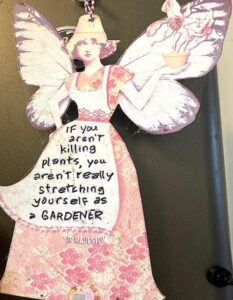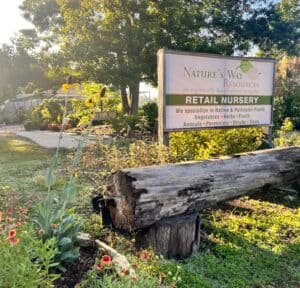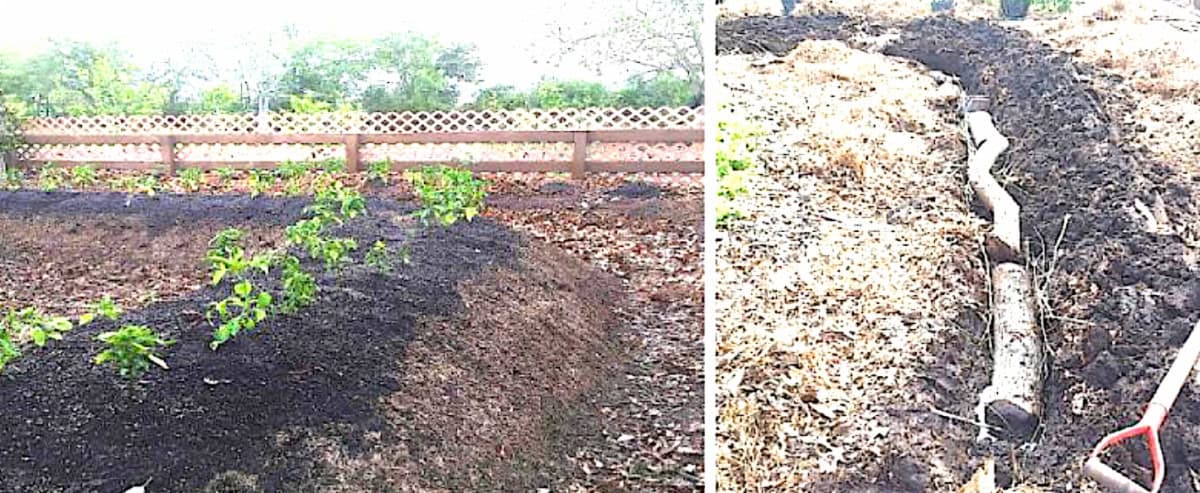 Nature’s Way Resources is proud to produce & email you this free weekly newsletter. We have no ads, but sponsors do graciously help support this project as a public service. Please note their names below & show your gratitude for this free service by patronizing their businesses! To become a sponsor, call (936) 273-1200
Nature’s Way Resources is proud to produce & email you this free weekly newsletter. We have no ads, but sponsors do graciously help support this project as a public service. Please note their names below & show your gratitude for this free service by patronizing their businesses! To become a sponsor, call (936) 273-1200
Nature’s Way Resources owner John Ferguson, “The Lazy Gardener” Brenda Beust Smith and Pablo Hernandez welcome your feedback and are so grateful to the many horticulturists who contribute their expertise
Click here to join our email list
CLICK HERE for PDFs OF PAST LG&F NEWSLETTERS
 “If you are not killing plants, you are not really stretching yourself as a gardener!”
“If you are not killing plants, you are not really stretching yourself as a gardener!”
— Dr. J.C. Raulston
BY BRENDA BEUST SMITH
My favorite gardening quote – hangs on my refrigerator (above)! The late Dr. J. C. Raulston (1940-1996) was one of our nation’s premier gardening leaders, credited with introducing/promoting more plants into contemporary horticulture than anyone else during the latter part of 20th century, mainly through the now named J. C. Raulston Arboretum at North Carolina State University. We all owe him a great deal of gratitude!

WONDER WHAT TO DO WITH YOUR BERLE-GIFTED TREE STUMP?
The Internet is full of fun ideas. Some tips from pros:
- Use solid stumps that have not started to decay. (Healthy mature tree stumps can take years to decay.)
- Best not to do a “tree” in a tree stump. Select shallow rooted perennials, (maybe add annual plants until perennials set roots and start blooming).
- Drill or carve (chainsaw, ax, etc.) out a “bowl” big & deep enough for desired plants future root-growth . Leave inch or two border of stump with bark (as shown) around outer edge.
- Drill drainage holes in stump sides below this “bowl” for our heavy rainy periods.
- In plant hole, first lay a couple of inches of gravel, then GOOD soil.
- Repeating plantings also around stump base will add more eye-interest.
- Internet is full of “stump gardens” hosting flowers, foliage plants, vegetables, etc.
- That birdbath (right) is probably just a tin pie-pan in a shallow recess.
One warning: don’t pick a stump too close to your house. Stumps may attract pests and insects. Decay time depends on multiple factors. Some stumps stay solid for decades. Others may show decay sooner than later. Keep an eye out!
GARDEN NOT TURNING OUT AS YOU’D LIKE? Or just looking for something new to try (and maybe wow the neighbors)? Today’s two great Spotlight Articles below should cover all bases!
- In our first SPOTLIGHT ARTICLE, Waller County Master Gardener MARY KHAZEN KARISH shares her expertise (here for second time), noting: “Hugelkultur, an ancient form of sheet composting, has been practiced in Eastern Europe for centuries . . . mimics composting cycle forests go through every year.” Have more questions? sugarlandgardenclub.org
- In our second SPOTLIGHT ARTICLE, Fort Bend County Master Gardener BARBARA BUCKLEY reports on the quick-growing, cool-season, favorite-Italian-cooking-ingredient: Rapini broccoli (broccoli raab). It has proven so successful in their Rosenberg Extension greenhouse, FORT BEND COUNTY MASTER GARDENER 1402 Band Rd., Rosenberg. FBMG.org
 ATTN. GARDEN/PLANT GROUPS — In wake of Hurricane Beryl, Nature’s Way Resources offers free guided tours of NWR’s extensive nursery/soil/mulch facilities for garden clubs, plant societies and other plant-oriented, organized groups. As usual, NWR’s now-expanded meeting site is free to above groups. Reservations a must for both.
ATTN. GARDEN/PLANT GROUPS — In wake of Hurricane Beryl, Nature’s Way Resources offers free guided tours of NWR’s extensive nursery/soil/mulch facilities for garden clubs, plant societies and other plant-oriented, organized groups. As usual, NWR’s now-expanded meeting site is free to above groups. Reservations a must for both.
“LAZY GARDENER’S GUIDE” (PDF format) is emaild free. Request: lazygardenbrenda@gmail.com
Brenda Beust Smith’s column is based on her 40+ years as the Houston Chronicle’s “Lazy Gardener” column — lazygardenerbrenda@gmail.com Brenda’s column focuses ONLY on the Greater Houston Area
Spotlighting
SUGAR LAND GARDEN CLUB

Left, Mary Karish’s Hugelkultrer mound with peppers topped with compost. Right, replenishing the mounds with wood logs (Mary Karish photos above and below)
HUGELKULTURE: BUILDING FERTILE SOIL WITH WOOD LOGS
by MARY KHAZEN KARISH
Waller County Master Gardener
Forests have existed for thousands of years without landscaping companies installing irrigation systems or chemical companies fertilizing the soil. Trees grow as tall as buildings, trunks expand to almost the size of a trailer and branches extend as far as the eye can see. How do they do it?
Hugelkultur, an ancient form of sheet composting, has been practiced in Eastern Europe for centuries. Its German translation, “Hill Culture,” mimics the composting cycle forests go through every year. It starts with the following steps:
- Clear the sod from the desired area or place thick overlapping cardboard.
- Assemble the biggest wood logs you have available. Most types of wood work, whether fresh or rotting.
- However, stay away from cedar or black walnut as they contain naturally occurring herbicides or toxins.
- Cover with wood sticks and tree trimmings, water the pile generously.
- Add 2 to 3 inches of organic matter, such as grass clippings, leaves, vegetable scraps or manure.
- Then add 2 to 3 inches of compost and water the pile
- Finally, cover it with leaves or wood chips to keep the pile moist and weeds from camping on your Hugelkultur mound

Left, replenishing the mounds with wood logs. Right, the Author’s Hugelkultur mound planted with peppers topped with compost.
Sit back, and let nature do the work for you. As time goes by, the wood logs and branches decompose much like the natural composting process in the forest. As they rot, they become like a sponge extracting moisture and slowly releasing it into the soil, eliminating the need for irrigation. Simultaneously, the rotting wood becomes the source of organic matter that all living plants need to grow.
The bigger the mound the longer it would take to decompose. A mound that is 5 feet high would take about 5 to 7 years to decompose completely. If you do not have access to wood logs, branches and sticks will do. However, the rate of decomposition will go faster. You can replenish the mound after each planting season by adding a layer of twigs or branches.
Hugelkultur is like aging wine, it gets better with time. You will also discover you do not need to dispose of yard waste because you will be using them!
Spotlighting
FORT BEND MASTER GARDENERS

LOOKIN FOR A QUICK-GROWING, COOL-SEASON VEGETABLE TO GROW?
By BARBARA BUCKLEY
Fort Bend County Master Gardener
Fort Bend County Master Gardeners are growing Rapini broccoli, also known as broccoli raab, in the Extension greenhouse in Rosenberg.
Known as “cima di rapa” or “rapini,” this robust and rich-tasting traditional Italian heirloom is a quick-growing, cool-season favorite. This high-yield broccoli is grown for flavorful, tender flower shoots and leaves which have a wonderfully delicate and slightly bitter, peppery broccoli flavor.
Rapini is a member of the Brassicaceae (mustard) family. It is an Italian non-heading broccoli. Rather than having a single head of broccoli, the plant produces side shoots. These vitamin-rich greens can be harvested as needed and the plant will continue to produce more shoots resulting in a longer harvest time. Rapini is wonderful sautéed, boiled, or baked. It can be enjoyed in salads, stir-fries, or steamed. Add it raw to salads for a healthy meal. This vegetable is high in vitamin A and so delicious!
This cool-season vegetable needs at least 6 hours of direct sunlight daily and likes a well-drained, organic soil. Fertilize the plants and water them regularly; they need consistent moisture throughout the growing season. Both leaves and 7 to 8 inches of flowering stalks can be harvested when heads are light and before flower buds open for best flavor. You can harvest when the flower buds begin to form. Cut the stem just below the bud.
After cutting, water plants well for a second harvest in a few weeks. Treat as a cut-and-come-again plant. The plant will continue to produce new buds for several weeks. Regular harvesting encourages continued production. At maturity, the plant reaches a height of 20 to 28 inches. The flavor improves with cooler weather.
John’s Corner
NEWS FROM THE WONDERFUL WORLD
OF SOIL AND PLANTS # 303
Subject: Prairies GMO Atrazine Lawns and Climate Fluoride
I recently read the book titled “Prairie Up – An Introduction to Natural Garden Design”, by Benjamin Vogt. 978-0252086779, 2023, University of Illinois Press. The author gave some interesting data comparing one acre of forest to one acre of prairie in Wisconsin.
In the timberland there are 90 tons of plant biomass above the soil per acre and another 80 tons of biomass in the top 42 inches of soil.
By comparison the tall grass prairie 3 tons of biomass above the soil per acre and a whopping 150 tons of biomass in the top 42 inches of soil. He also stated that one square yard of a big bluestem patch has 25 miles of roots!
This explains why the extremely rich organic prairie soil was plowed up and became the breadbasket of America.
France’s Food Safety Organization published a devasting report on the dangers of GMO foods (genetically modified). It calls for monitoring and testing of these crops for both environmental the socio-economic impacts.
In the case studies risk repeatedly from changes in nutritional profiles to increased allergenicity, toxicity issues, to long term risks from escaped genes.
The European Union has banned the agricultural weed killer Atrazine, that is linked to infertility, reproductive problems, and fetal development.
It is amazing to me how a toxic chemical in Europe is considered safe by the EPA and USDA on the other side of the Atlantic ocean.
More reasons to grow our own food organically whenever possible.
In my Crop Science newsletter, a while back there was some interesting data on global warming (carbon and other emissions). When lawns are managed intensively (mowing, irrigation, and use of artificial fertilizer) a half-acre will produce about 20,000 kilograms of greenhouse emissions.
When the lawns are managed (no mowing or irrigation and used only organic fertilizers) the same half-acre would sequester about 80,000 kilograms.
All gardeners need to use modern organic methods in our gardening and lawn care and be part of the solution, as they work better and cost less.
We have talked about the dangers of fluoride in our water systems many times. How it weakens many plants’ immune system, so they become more susceptible to insects and disease. Or how it contributes to creating hardpan soils. Not to mention the human health problems it causes.
A federal court has ruled the current levels of fluoride in drinking water pose an unreasonable risk of injury to public health, particularly to children’s cognitive development! “Fluoride exposure, even at levels considered “optimal” for dental health has been linked to lower IQ and other neurological effects”.
The finding was based on risk as defined in the Toxic Substances Control Act (TSCA). They reviewed over 70 studies that showed fluoride was dangerous, especially to children. The court found the EPA negligent in protecting our population.
I wonder how much fluoride contributes to the violence in schools and the school shootings by our youth?
As a result, several cities have already decided to quit poisoning the water supply with mandated fluoridation.
Note: Adding fluoride to water systems saves polluting companies billions of dollars every year in hazardous waste disposal fees. The book below is by a whistle blower on how private companies control the EPA.
 Science For Sale: How the US Government Uses Powerful Corporations and Leading Universities to Support Government Policies, Silence Top Scientists, Jeopardize Our Health, and Protect Corporate Profits, by David Lewis, PhD., Skyhorse Publishing, 2014, ISBN: 978-1-62636-071-6
Science For Sale: How the US Government Uses Powerful Corporations and Leading Universities to Support Government Policies, Silence Top Scientists, Jeopardize Our Health, and Protect Corporate Profits, by David Lewis, PhD., Skyhorse Publishing, 2014, ISBN: 978-1-62636-071-6
Note: All proceeds from this book go to the National Whistle Blower’s Center (www.whistleblowers.org)
SPONSORSHIP
If you are interested in becoming a sponsor, please contact us at 936-273-1200 or send an e-mail to: lazygardenerandfriends@gmail.com
ABOUT US
BRENDA BEUST SMITH WE KNOW HER BEST AS THE LAZY GARDENER . . . but Brenda Beust Smith is also:
- a national award-winning writer & editor
- a nationally-published writer & photographer
- a national horticultural speaker
- a former Houston Chronicle reporter
When the Chronicle discontinued Brenda’s 45-year-old Lazy Gardener” print column — started in the early ’70s as a fun side-project to reporting, it then ranked as the longestrunning, continuously-published local newspaper column in the Greater Houston area. The name, she says, is not just fun, it’s true. Brenda’s gradual sideways step from reporter into gardening writing led first to an 18-year series of when-to-do-what Lazy Gardener Calendars, then to her Lazy Gardener’s Guide book which morphed into her Lazy Gardener’s Guide on CD, which she now emails free upon request. Brenda became a Harris County Master Gardener and, over the years, served on theboards of many Greater Houston area horticulture organizations. She hosted local radio and TV shows, most notably a 10+-year Lazy Gardener specialty shows on HoustonPBS (Ch. 8) and her call-in “EcoGardening” show on KPFT-FM. For over three decades, Brenda served as Assistant Production Manager of the GARDEN CLUB OF AMERICA’S “BULLETIN” magazine. Although still an active broad-based freelance writer, Brenda’s main focus now is THE LAZY GARDENER & FRIENDS HOUSTON GARDEN NEWSLETTER with John Ferguson and Pablo Hernandez of Nature’s Way Resources. A native of New Orleans and graduate of St. Agnes Academy and the University of Houston, Brenda lives in Humble, TX, and is married to the retired Aldine High School Coach Bill Smith. They have one son, Blake. Regarding this newsletter, Brenda is the lead writer, originator of it and the daily inspiration for it. We so appreciate the way she has made gardening such a fun way to celebrate life together for such a long time.
JOHN FERGUSON
John is a native Houstonian and has over 35 years of business experience. He owns Nature’s Way Resources, a composting company that specializes in high quality compost, mulch, and soil mixes. He holds a MS degree in Physics and Geology and is a licensed Soil Scientist in Texas.
John has won many awards in horticulture and environmental issues. For years he represented the composting industry on the Houston-Galveston Area Council for solid waste. His personal garden has been featured in several horticultural books and “Better Homes and Gardens” magazine. His business has been recognized in the Wall Street Journal for the quality and value of their products. He is a member of the Physics Honor Society and many other professional societies. John is the co-author of the book Organic Management for the Professional.
For this newsletter, John contributes articles regularly and is responsible for publishing it.
PABLO HERNANDEZ Pablo Hernandez is the special projects coordinator for Nature’s Way Resources. His realm of responsibilities include: serving as a webmaster, IT support, technical problem solving/troubleshooting, metrics management and quality control. Pablo helps this newsletter happen from a technical support standpoint.
Download the Newsletter with Our Events Calendar Below!



